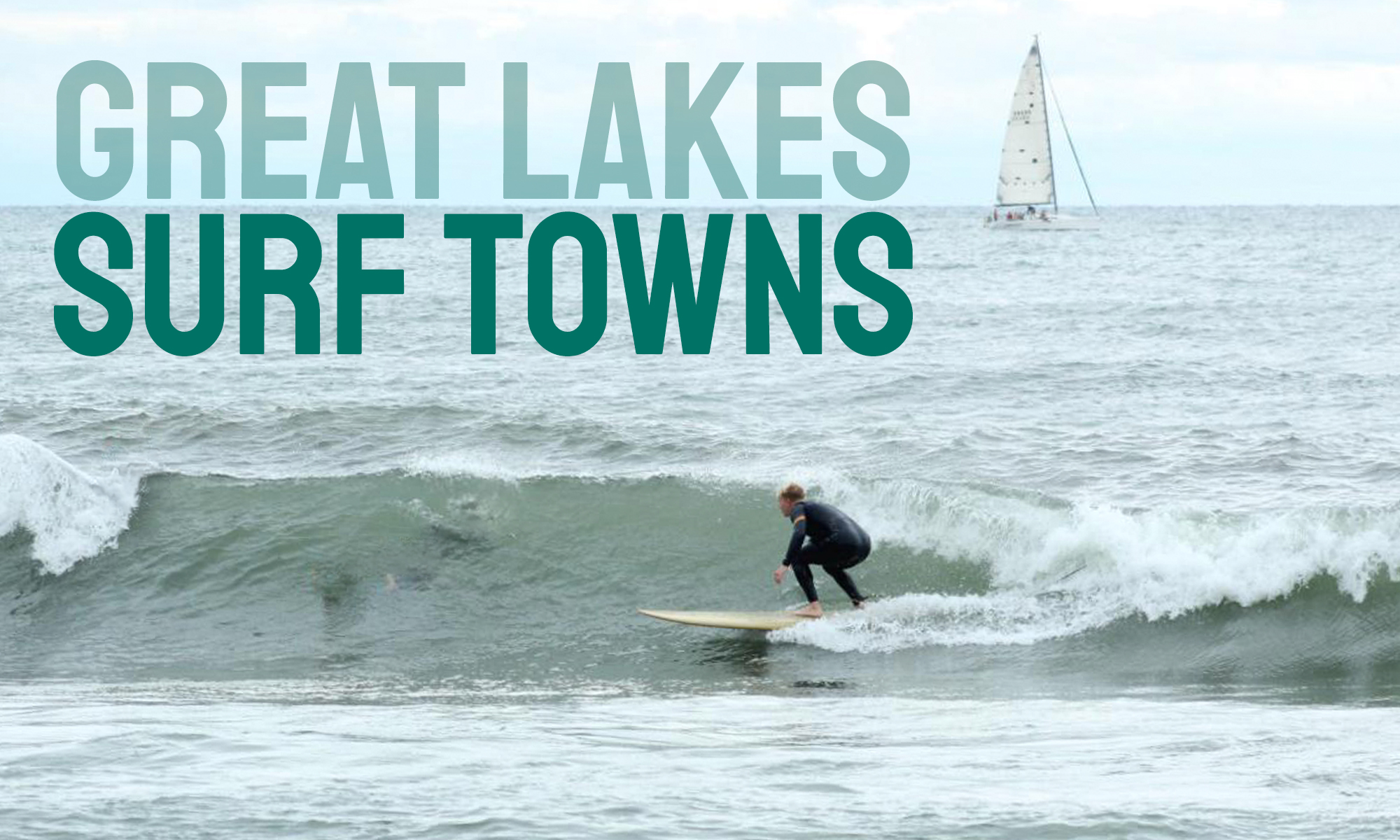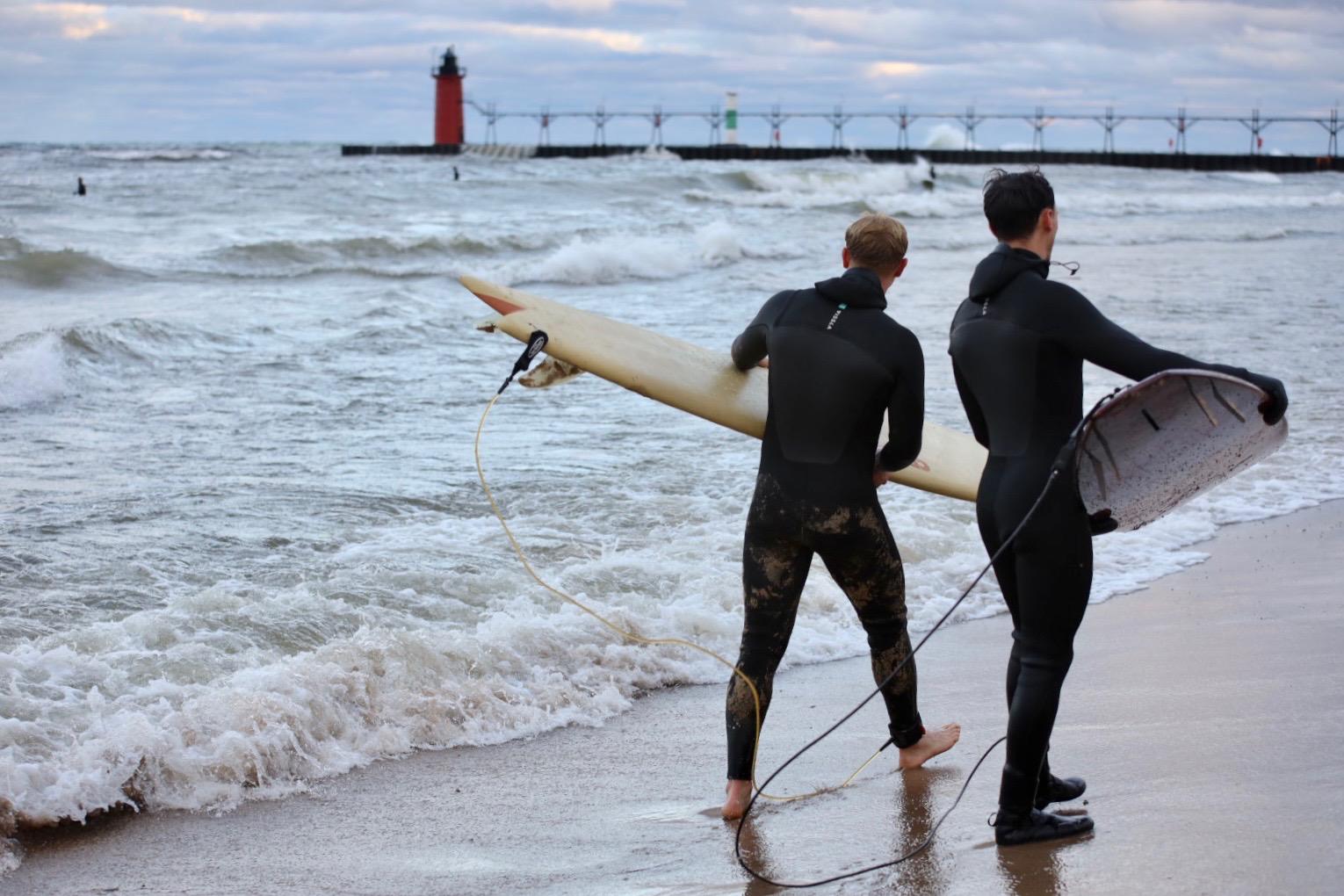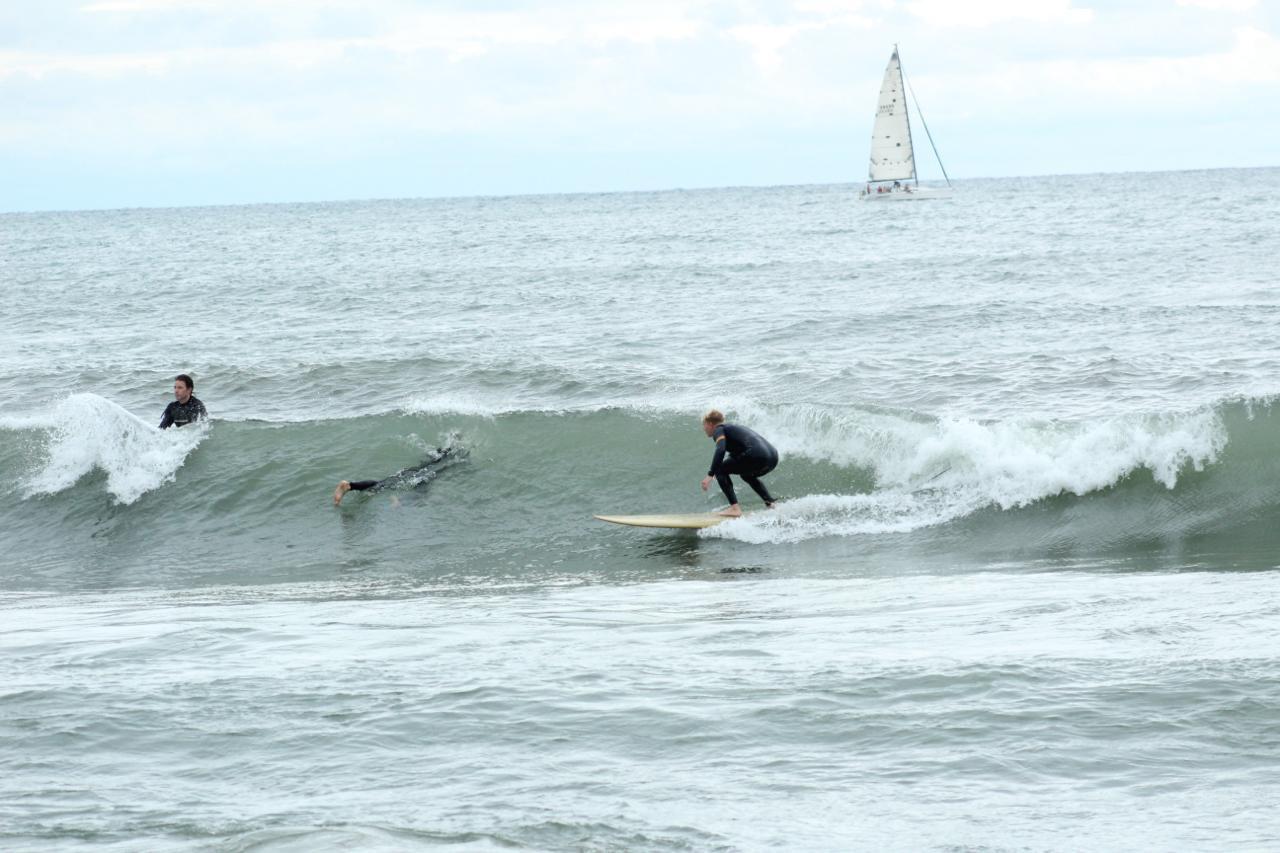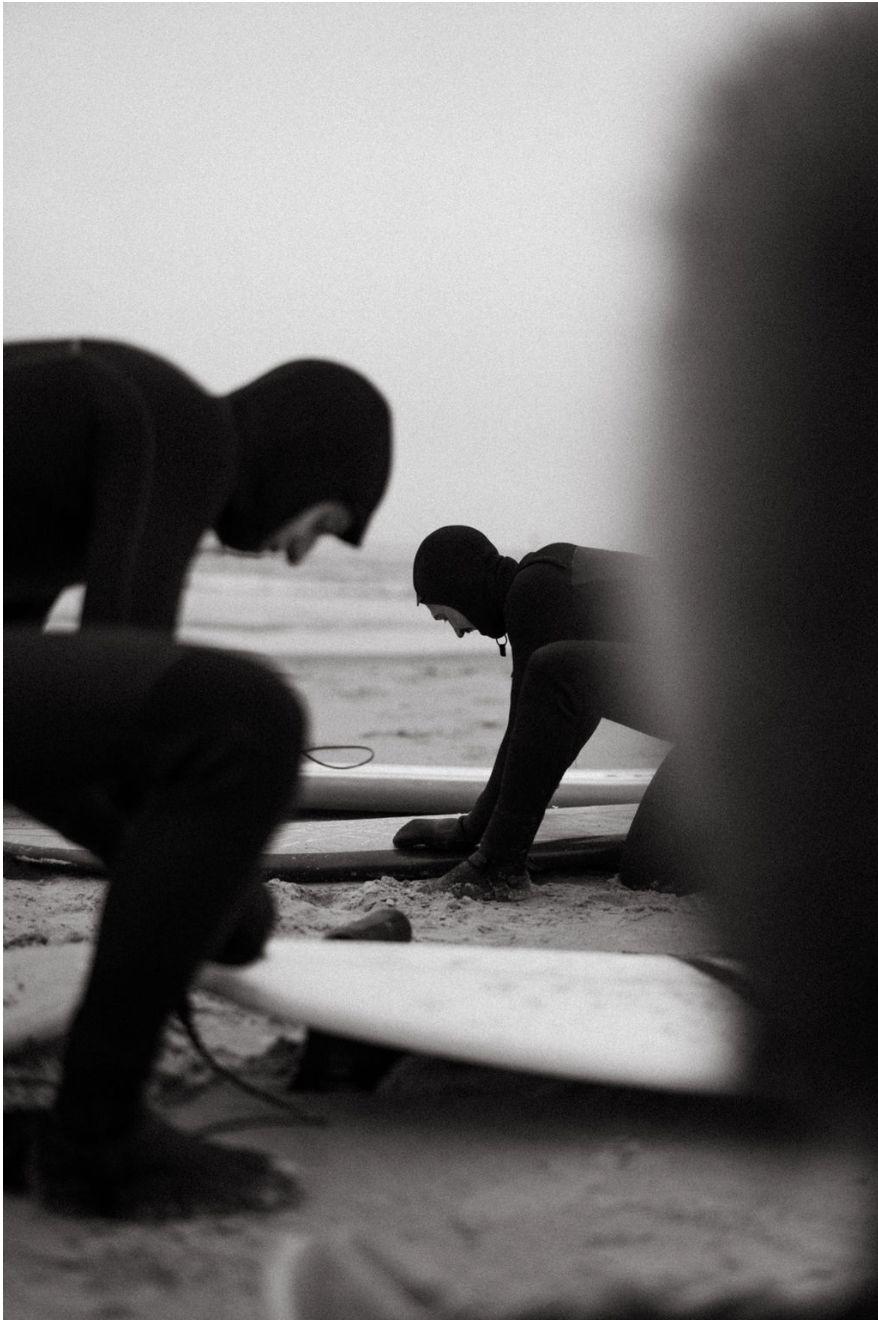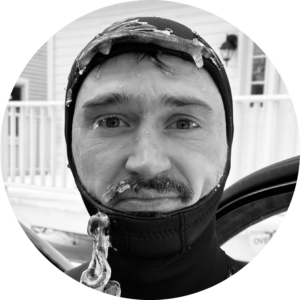Photo: Five Lakes Surf Club | Digital Art: Stephanie Thwaites
Great Lakes Surf Towns
Community, Culture, and Cold Waves
Story By: Giles Schlehuber
Chicago, Milwaukee, Duluth, Cleveland, Sheboygan, Grand Haven, and Buffalo are just a few of more than two hundred towns spotting the shores of the Great Lakes. Some are city hubs, Rust Belt towns, or quaint fishing villages, but you can count on them to have a surfboard or two sitting in a garage or gracing the waters when the swell is up.
Our response to the age-old statement, “You can’t surf on a lake!” is to introduce our fellow Midwesterners to the decades-long stoked surf community in these towns along the lakes.
Surfing in the Great Lakes is not far in the timeline from surfing in California. The first known lake surfer, Doc Seibold, was surfing in Grand Haven in 1955. That’s six years before the Beach Boys dominated American cultural headspace. About a decade later, at the absolute peak of surf craze, the Great Lakes Surfing Association was formed.
Seventy years later, surfing in the Great Lakes has only grown from its humble beginnings. Generations have passed the torch, and newcomers have entered the scene with all kinds of surfers, old and young. Surfboard shapers and surf shops have popped up along cities, helping to supply hand crafted boards and surf gear to locals. These spaces act as a kind of “third place” for surfers to congregate and share stories.
Photo: Five Lakes Surf Club
If you’re witnessing the action in real time, chances are you’re watching during peak surf season. Surfing in the Great Lakes is primarily done in the late fall and winter – making it only slightly colder than the sunny SoCal or Australian destinations that surfing brings to mind.
The Midwestern surfer relies on local storms to kick up waves rather than far away swells in the ocean. Surfing here is possible because of the volatile weather patterns that cause even the sturdiest Midwesterner to shake their head. At the same time, near a Great Lake, your Midwest surfer is fighting his way into his thick, 6mm wetsuit, eager to score freshwater surf.
If surfing the Great Lakes is still sounding questionable to you, stick with us. Ocean dwellers might tell you the merit of a surf town is in its sunshine or fresh squeezed mango margaritas on the beach, or maybe it’s the consistency of waves.
It’s hard to argue. But as Midwesterners, we have something truly special. Surfers here actually know each other’s names. We look out for each other and we smile while we’re surfing (even in blizzards!). Each town has their own special flair — like a sauna after a cold session, a cold beer at a Midwest brewery in August, a natural point break on freshwater beaches, or a short walk through our vibrant woods in the fall.
Photo: Five Lakes Surf Club
Chicago, Illinois
Kelly Slater believes in Chicago surfing, and that’s enough for us.
Chicagoland: the metropolitan area is home to nearly 10 million people, and the city has 3 million itself. There are upwards of 100 local surfers, depending on who you ask. These surfers are perfectly situated in the city with sandy beaches receiving almost 300 miles of fetch on a north swell.
Chicago has two dozen beaches along its coastline, but there’s a catch: surfing is restricted at all but two during summer. When peak surf season hits, more beaches open. In some surf towns—especially metropolitan ones—rebar, construction, and pollution are the main concerns. That’s all true for Chicago, but maybe the most intrusive obstacle is people themselves: swimmers and unknowing onlookers. The Chicago Police Department is well acquainted with the surf community via concerned callers.
Times are better and tensions are lower, but there was a time when surfing was outright illegal within the city, leading to arrests and media attention. Insert Kelly Slater, and you have a grassroots movement for the Chicago Chapter of the Surfrider Foundation, formed and chaired by Mitch McNeil. Thanks to advocacy from pioneer arrestees Jack Flynn and Rex Flodstrom, Chicago continues to preserve its surf access and culture.
More community support comes from Patagonia Chicago and Montrose Beach Surf Club. The local Patagonia hosts events, advocates for water quality, and supplies gear, while MBSC, formed by Mark Molinari, operates as a joint IG page and WhatsApp groupchat for locals.
Surfing in a freshwater metropolis has its share of red tape, but the city has a passionate and dedicated community. And if you’ve ever surfed here on a strong NW swell, you know why it’s worth protecting.
Grand Haven, MI
It’s impossible to overemphasize the cultural and historic relevance of Grand Haven, MI. These golden, sandy shores are likely the epicenter of this whole thing we call Great Lakes surfing.
“Surf City”, Grand Haven, has surf history dating back to the 50s with Hawaiian roots. The 60s swept the nation, and Grand Haven’s culture only grew, with locals Rick Sapinski and Terry Laug forming the Great Lakes Surf Association. GLSA would go on to host competitions, throw parties, and bring people together.
The 70s came and went, and short boards came and stayed. Surfers ditched their longboards and found shelter near pier heads. With shortboards, they could tuck into bigger peaks, but any lake surfer knows the struggle on smaller days.
Enter The Rockpile.
Normally, you surf the north side pier for protection on a south wind, but when waves bounce off the south pier on a south wind, bigger peaks form and head toward shore. It’s a difficult, messy wave to predict with a lot of energy. And Grand Haven surfers have claimed it as their own. They are called the Rockpile Gang.
Decades have passed, and surfers are still tucking into waves at the Pile. It’s so popular that even non surfing locals recognize the culture. Many contests have been held, and the community remains strong with possibly the largest concentration of high school groms in any lake spot.
More than any other town, the lineup is filled with groms and legends alike – Matt Smolenski is well known as one of the most skilled locals. Ken Smith of No Coast Surf Boards is one of the oldest, frequently surfing the Pile along with Phil Murphy and Will Beaton. The town has lots of younger talent, too.
Vince Deur of Grand Haven directed the essential lake surfing film, Unsalted. Calling yourself a lake surfer without seeing this movie is like calling yourself a cop with no badge. And June 10, 2025, is the 20-year anniversary.
Other towns may have bigger waves and surf the proper side of the pier, but Grand Haven is the King of Great Lakes surfing culture.
Source: sandhillcity.com
Duluth, MN
The coldest days can reach -40°F windchill. Boulders extending above the waterline are clothed in sheets of ice. Swells travel 350 miles west across vast Lake Superior, generating explosive waves on the rocky shores. Dangerous waves of consequence make the name “The North Shore” a fitting parallel.
Duluth, MN, the farthest end of the lake, is the start of the North Shore of Lake Superior. It was first surfed in the mid-‘70s by surf pioneer Greg Isaacson after returning from Hawaii.
Today, up to fifty surfers call Duluth their local spot, some coming from the border in Wisconsin or as far as the Twin Cities. Though a modest count, a wealth of talent and history lies within the community. The locals in town have nourished their scene with a family business forming the core.
The Back Alley Surf Shop is what you want your local surf shop to be: a hangout with coffee, food, live acoustic music, running clubs, board swaps, and some of the finest handcrafted lake boards.
In town, you might rub elbows with local elders Greg Isaacson, Erik and Yvonne Wilkie, and Randy Carlson, who will all readily offer advice or stories. Riah and Jerome own The Back Alley, Riah being an excellent photographer alongside fellow photographers Matthew Pastick, Ryan Rumpca, and Jake Pearson. There also lives here a humble and hugely talented shaper with his head down, studiously working and refining his craft—you can find him if you search. 😉
In a land as fierce and rugged as the North Shore, community is very important not only for encouragement and joy but also for safety. Surfing in extreme cold with strong currents and a rocky bottom is not a sport for the uninitiated. The breaks near Duluth are a testing ground for the hardiness of Great Lakes surfers.
A historic shipping port city in Minnesota is maybe the least likely candidate for one of the most vibrant cold-water surfing scenes around. Yet, this is what you get when you nurture the aloha spirit for over fifty years at one of the best waves in the lakes.
Photo: Five Lakes Surf Club
Each Great Lakes surf town has a rhythm, shaped by weather, water, and community. These highlights are just a glimpse into the broader Great Lakes Surf Towns series by Five Lakes Surf Club. Follow along on Instagram @FiveLakesSurfClub to catch the full series, see which town gets featured next, and throw in your two cents on where we should head next.
Naysayers will tell you it’s not possible to surf on a lake. If only we could hear them over the sound of wind and whoops and hollers of Great Lakes surfers having a ball.

